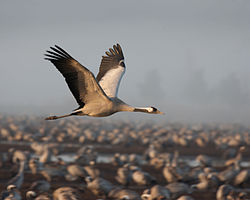Common crane
The common crane (Grus grus), also known as the Eurasian crane, is a bird of the family Gruidae, the cranes. It is a medium-sized species, and classified as of least concern.[1] It is the only crane commonly found in Europe apart from the demoiselle crane.
| Common crane | |
|---|---|

| |
| Conservation status | |
| Scientific classification | |
| Kingdom: | |
| Class: | |
| Order: | |
| Family: | |
| Genus: | |
| Binomial name | |
| Grus grus | |
Habitat
In Europe, the common crane breeds in boreal and taiga forest and mixed forests, from sea-level to 2,200 m (7,200 ft). It also lives on treeless moors, on bogs, or on dwarf heather habitats, usually where small lakes or pools are also found.
In Sweden, breeders are usually found in small, swampy openings amongst pine forests while, in Germany, marshy wetlands are used. Breeding habitats in Russia are similar, though they can even be found nesting in the steppe and in semi-desert, so long as water is near. Mostly, common cranes are found breeding in wooded swamps, bogs and wetlands. They seem to need quiet, peaceful enivrons with little human interference. They live in low density, from 1 to 5 pairs per 100 km2 (39 sq mi).
During winter, the birds move to flooded areas, shallow sheltered bays, and swampy meadows. During the flightless moulting period there is a need for shallow waters or high reed cover for concealment. Later, after the migration period, the birds winter regularly in open country, often on cultivated lands and sometimes also in savanna-like areas, for example on the Iberian Peninsula.
Back to Britain
Cranes are back in Britain after 300 years. They were devastated by the draining of the fens 300 years ago. This was a low-lying wetland which was one of their favourite habitats.[2]
Common Crane Media
Common crane (Grus grus)
"Departure of Cranes" - picture of 1870 by Józef Chełmoński (National Museum in Cracow)
A common crane in the coat of arms in the Tervola municipality
Adults in flight at Khijadiya Bird Sanctuary, Gujarat, India
References
- ↑ 1.0 1.1 BirdLife International (2012). "Grus grus". IUCN Red List of Threatened Species. Version 2012.1. International Union for Conservation of Nature. Retrieved 16 July 2012.
- ↑ Crane comeback (video clip). BBC Nature
| Wikimedia Commons has media related to Lua error in Module:Commons_link at line 62: attempt to index field 'wikibase' (a nil value).. |









